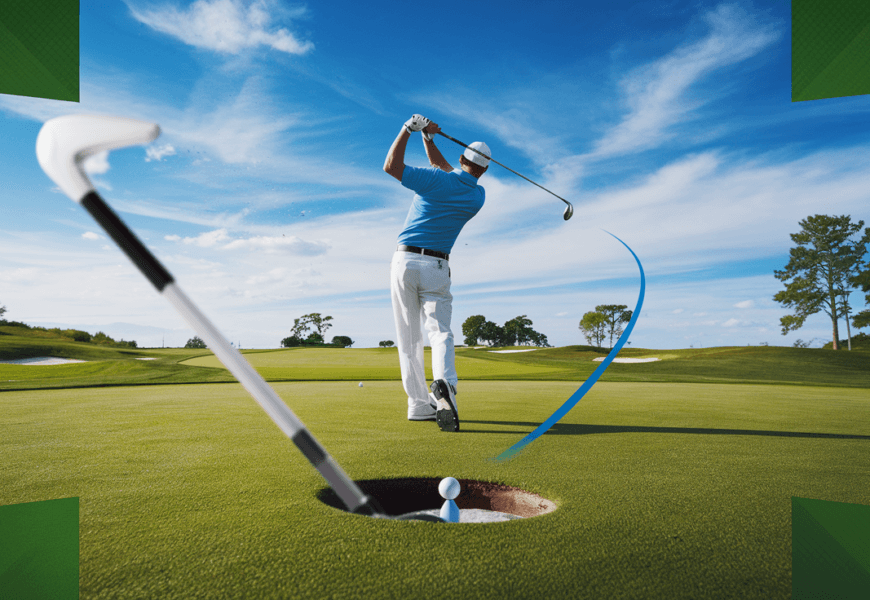Understanding Low Spin Golf Balls
Benefits of Low Spin Balls
Low spin golf balls are a game-changer for folks wanting to up their golfing step. Here’s why these balls are the bee’s knees:
Reduced Slice and Hook Hiccups
If your golf ball’s got a mind of its own, opting for low spin can tame that wild ride. Less sidespin means your shots fly straighter, making it a godsend for anyone battling unpredictable hooks and slices.
Boosted Distance
Looking to send the ball packing? Low spin balls might just be your ticket. By cutting down on backspin, they travel like a smooth criminal, carrying more yardage before deciding to take a roll for the bonus yards. Perfect for those of us who like playing the long game.
| Ball Type | Horizontal Travel Distance |
|---|---|
| High Spin | Okay-ish |
| Low Spin | Better |
Wallet-Friendly
Let’s get real – golf balls have a knack for disappearing. The good news? Low spin balls won’t break the bank at about $20 a dozen. Compare that to the $40+ for the fancy high-spin models, and they start looking even better.
Jump over to our section on cheap golf balls in bulk if bargain hunting is your tee time motto.
Last Longer
Built to withstand your fiercest swings, low spin balls tend to hold up pretty well. Thanks to their tough multi-layer makeup, they stick around for more games before biting the dust.
Drawbacks of Low Spin Balls
Gotcha, low spin balls ain’t all sunshine and rainbows. Watch out for a couple of bumps in the golf course:
Shot Fine-tuning? Not So Much
The downside? Trying to play Picasso around the green might feel harder. You could be left longing for the high-spin ball’s nifty spin tricks close to the hole. Artful short-game shots might need more finesse than low spin offers.
| Ball Type | Green-side Control |
|---|---|
| High Spin | Sharp |
| Low Spin | Meh |
Curious about high-spin wonders? Maybe swing over to high spin golf balls.
Doesn’t Feel as Fancy
You might notice a bit of toughness in the feel department with low spin balls. Fewer layers often translate to a firmer hit. If you’ve got a thing for soft and smooth, weigh this against the low spin’s perks.
Need for Speed (Balance)
Though low spin balls are all-around champs, they might not be every speed demon’s cup of tea. Fine-tuning with a pro can help you nail the choice ideal for your swing. For speed tweaks, the swing speed considerations guide might help clear the air.
Deciphering what makes low spin golf balls tick can lead you to a decision tailored to your swing. Whether you’re gunning for distance, keeping a tight budget, or more worried about durability, low spin balls pack a punch suitable for all kinds of players. Find more sage advice and tips in our in-depth article on the best golf balls for high handicappers.
Characteristics of Low Spin Golf Balls
Choosing low spin golf balls can be tricky, but knowing what makes them tick will lead to smarter purchases and possibly a better game.
Construction and Layers
Low spin golf balls usually have two or three layers—yep, they’re not about that complicated life. This straightforward design isn’t just easier on your wallet but also a lifesaver for high-to-middle handicap folks who zoom through golf balls like they’re going out of style.
| Type of Golf Ball | Layers |
|---|---|
| Low Spin | 2-3 |
| High Spin | 3-5 |
Fewer layers mean less spin and more control over your shots. You’re looking at straighter drives, which is fantastic news if you’re constantly battling those wild slices and hooks.
Durability and Cost
Durability is king when it comes to low spin golf balls. With a tough ionomer finish, these balls can handle a lot more abuse than their urethane-covered cousins. Translation? They last longer and save you cash over time.
| Type of Golf Ball | Approx. Cost (per dozen) | Material | Durability |
|---|---|---|---|
| Low Spin | $20 | Ionomer | High |
| High Spin | $40-50 | Urethane | Moderate |
For those keeping a keen eye on their budget, low spin golf balls are usually the most wallet-friendly option at your local shop. At about $20 a dozen, they’re a steal compared to those high spin, fancy ones that can cost you more than double. If you’re on the hunt for cheap golf balls in bulk, these are definitely worth considering.
These balls strike a balance between cost and performance, empowering you to make longer shots without blowing a hole in your finances. The combination of durability and lower spin creates a forgiving experience, helping many golfers step up their game.
To learn about other types of golf balls and what they offer, don’t miss our articles on high spin golf balls and best golf balls for distance.
Performance of Low Spin Golf Balls
Distance and Straightness
Low spin golf balls are like that friend who just gets you further in life—literally, they give you more distance and keep your shots on the straight and narrow. By cutting down on those pesky side spins, they help keep your shots from slicing off into the unknown or hooking right back at you (LinkedIn). When you strike one of these marvels, less backspin and sidespin mean your ball sails further with extra roll once it hits the turf. Who wouldn’t want to add a few more yards for good measure?
| Ball Type | Distance (yards) | Price (per dozen) |
|---|---|---|
| Low Spin | 260 – 280 | ~$20 |
| High Spin | 250 – 270 | ~$50 |
And let’s talk dollars and sense. At around $20 a dozen, these balls aren’t just flying off the greens—they’re a bargain compared to the high-spin, pro-level counterparts that can empty your wallet at $50 a pop (Golf-Info Guide). That’s a big win for beginners working on their strokes or the more seasoned swinger who’s keeping an eye on their budget.
Challenges in the Short Game
While they’re ace for straightening out those long drives, low spin balls can turn the short game into a bit of a balancing act. With less spin, they don’t always stick the landing around the green—that precision and stop-you-in-your-tracks power isn’t their forte (Stitch Golf). As I have experienced, those tricky approach shots or sneaky chips might roll on a tad more than you’d like.
| Area of Play | Advantage of Low Spin | Disadvantage of Low Spin |
|---|---|---|
| Driving | Increased Distance | Reduced Flight Control |
| Short Game | Less Slice/Hook | Harder to Stop on Green |
| Cost | More Economical | N/A |
So if you’re working on nailing your short game, you might occasionally lean toward higher spin balls for that extra control (Cedarwood Golf). But if your goal is to send it long and straight down the fairway, those trusty low spin golf balls are your sidekick of choice.
For even more wisdom on finding the perfect ball to match your style, check out these guides:
Suitability for Different Skill Levels
Low spin golf balls aren’t just for one type of player – they can be a game-changer for folks from newbies to the top dogs. Knowing how these balls work can help you pick the right ones for your game.
Novices and Intermediates
If you’re just starting out or somewhere in the middle, these balls are your best buds. Why? They help your shots go farther and straighter by cutting down on backspin and sidespin, meaning less zig-zag and more bang for your buck (Stitch Golf). That’s a win for newcomers trying to keep their shots straight and avoid those pesky hooks and slices that can spoil your day.
These balls don’t just fly straight; they also add consistency and control when you’re teeing off. Perfect for high handicappers struggling to keep it on the fairway. Less spin means fewer wild jumps, boosting user morale with confidence with every swing. Curious about why these might be the best golf balls for high handicappers? Check out our guide for more details.
Plus, they’re sturdy and won’t break the bank! These balls last longer, taking a lot of hits without getting beat up. They’re a budget-friendly choice for rookies who aren’t ready to splash out on pricy gear.
| Skill Level | Benefits |
|---|---|
| Beginners | More distance, straighter shots, better control |
| Intermediates | Better accuracy, steady game, affordable |
If you’re still thinking things over, you might also want to learn about golf balls for beginners.
Professionals’ Perspective
For those who’ve got their swing down pat, gear has to really match their play. Low spin golf balls have perks, but the pros often need pinpoint control, especially in the short game.
But hang on, some pros do turn to these balls when they’re all about distance and dead-straight paths. On long drives and tee-offs, the steady patterns mean you can trust it to go where it needs to, crucial in high-stakes situations (Cedarwood Golf).
Pros wanting a mix of range and touch might find low spin balls with top-notch cover materials, like urethane, fit the bill. They give enough control around the greens without giving up their strengths. Built to last, these are reliable companions through the whole game.
| Skill Level | Benefits |
|---|---|
| Professionals | Long shots, true path, dependable performance |
Looking for something precision-focused? Our take on high spin golf balls might be up your alley.
Low spin golf balls have a little something for everyone: distance and control for learners, with the trustworthy performance that skillful players depend on. Play around with different types and tailor them to your style and needs. Want to add a personal twist? Check out personalized golf balls to bring more flair to your game.
Factors Influencing Golf Ball Selection
Choosing the perfect golf ball is not as simple as grabbing the first one off the shelf. There’s a bit of science—and a sprinkle of strategy—involved. Understanding these little details can seriously up your golf game.
Swing Speed Considerations
Your swing speed isn’t just a number; it’s a game-changer when picking a golf ball. Different balls are made to suit varying swing speeds, helping you get the most out of your swing, whether that’s about distance or control—or both.
Slow Swing Speed
If your swing speed is on the slower side (under 85 mph), you’ll want a low-compression ball. This type of ball is your best friend because it’s easier to hit far and straight. These babies are built to give more distance and a straighter path, cutting down on those pesky hooks and slices.
Moderate Swing Speed
Got a moderate swing speed (85-95 mph)? Lucky you! You’re in a sweet spot where you can play around with more types of golf balls. Low spin balls could be your go-to, offering forgiveness and a bit more accuracy.
Fast Swing Speed
For those who swing at lightning speed (over 95 mph), you need a ball that can handle the impact. Low spin balls for you mean less spray from the tee and more command over your game.
Dimples, Cover Types, and Trajectories
The design of a golf ball—its dimples, the cover—these little guys play a huge role in how the ball flies and behaves in the air.
Dimples
Dimples aren’t just for looks. More dimples usually keep the ball stable, flying consistently without a mind of its own. So, you can aim straight, and it’ll help you get there.
| Number of Dimples | Flight Characteristics |
|---|---|
| 300-400 | Flies lower, better control |
| 400-500 | Flies higher, more distance |
Cover Types
Golf balls wear different skins, and each has its own feel and function:
- Surlyn: Tough and affordable, these covers are often on low spin balls. Tough cookie for hitting long.
- Urethane: Soft and a bit pricier, but worth it for better control, especially around the greens.
Trajectories
Low spin balls send the ball reliably downrange with less side-to-side shuffle. If you’re all about accuracy, these could tighten your game, offering less curve and more forgiveness.
Picking the right golf ball is all about matching it with how you play. For more tips, check out our guide on the best golf balls for high handicappers or find ones suited for golf balls for beginners.
Busting Golf Ball Myths
Choosing your golf ball isn’t rocket science, but the right one can sure change your game. Let’s clear up some myths about golf balls so you can pick what’s really gonna help you play better.
Soft vs. Hard Balls
People often think a softer ball is always better. Surprise, it’s not that simple! The real deal is how that ball fits your swing and style. A softie doesn’t guarantee you’ll start hitting like a pro (Golf Ball Nut).
Deciding between soft and hard balls should match up with how you play and what feels right. Soft ones can help with higher launch angles and boost your confidence with ball striking (GolfWRX Forum). On the flip side, harder balls can give you more control, especially in those gusty winds.
Don’t be shy about trying both types. Go with what matches your style. Need more tips on picking the top golf balls for distance? We’ve got a handy guide on best golf balls for distance.
Compression and Swing Match-Up
There’s another myth rolling around that high-compression balls are only for folks with blazing fast swings. Sure, they’re recommended for fast swingers, but it’s not set in stone (MyGolfSpy’s Ball Lab).
The best compression isn’t just about speed; it’s also about how you swing and hit the ball. Pairing a gentle swing with a soft ball isn’t the full story. It’s about how your swing matches the ball’s compression for perfect play. Take my friend Pat, who’s got a moderate swing speed — they found joy trying out different compression levels.
Table: Compression Fit
| Swing Speed | Ideal Compression |
|---|---|
| Low (≤ 85 mph) | Low Compression (≤ 70) |
| Medium (85-100 mph) | Medium Compression (70-90) |
| High (≥ 100 mph) | High Compression (≥ 90) |
Trying different golf balls is like finding the perfect dance partner for your swing style. Whether you’re a newbie or have played for years, there are golf balls for beginners and senior players that are just right for you.
Wrap-Up
Busting these myths can lead you to the right golf ball for a better game experience. Whether you’re puzzled between soft or hard balls, or digging into compression details, the bottom line is finding one that jives with your style. Check out our insights on colored golf balls and personalized golf balls to add a personal touch to your play.



